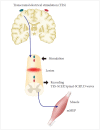Cervical Spondylotic Myelopathy: Natural Course and the Value of Diagnostic Techniques -WFNS Spine Committee Recommendations
- PMID: 31607071
- PMCID: PMC6790728
- DOI: 10.14245/ns.1938240.120
Cervical Spondylotic Myelopathy: Natural Course and the Value of Diagnostic Techniques -WFNS Spine Committee Recommendations
Abstract
Objective: This study presents the results of a systematic literature review conducted to determine most up-to-date information on the natural outcome of cervical spondylotic myelopathy (CSM) and the most reliable diagnostic techniques.
Methods: A literature search was performed for articles published during the last 10 years.
Results: The natural course of patients with cervical stenosis and signs of myelopathy is quite variable. In patients with no symptoms, but significant stenosis, the risk of developing myelopathy with cervical stenosis is approximately 3% per year. Myelopathic signs are useful for the clinical diagnosis of CSM. However, they are not highly sensitive and may be absent in approximately one-fifth of patients with myelopathy. The electrophysiological tests to be used in CSM patients are motor evoked potential (MEP), spinal cord evoked potential, somatosensory evoked potential, and electromyography (EMG). The differential diagnosis of CSM from other neurological conditions can be accomplished by those tests. MEP and EMG monitoring are useful to reduce C5 root palsy during CSM surgery. Notable spinal cord T2 hyperintensity on cervical magnetic resonance imaging (MRI) is correlated with a worse outcome, whereas lighter signal changes may predict better outcomes. T1 hypointensity should be considered a sign of more advanced disease.
Conclusion: The natural course of CSM is quite variable. Signal changes on MRI and some electrophysiological tests are valuable adjuncts to diagnosis.
Keywords: Cervical spondylotic myelopathy; Electrophysiology; Intraoperative monitoring; MR signal intensity; Magnetic resonance imaging; Myelopathic signs.
Conflict of interest statement
The authors have nothing to disclose.
Figures


References
-
- Acharya S, Srivastava A, Virmani S, et al. Resolution of physical signs and recovery in severe cervical spondylotic myelopathy after cervical laminoplasty. Spine (Phila Pa 1976) 2010;35:E1083–7. - PubMed
-
- Rhee JM, Heflin JA, Hamasaki T, et al. Prevalence of physical signs in cervical myelopathy: a prospective, controlled study. Spine (Phila Pa 1976) 2009;34:890–5. - PubMed
-
- Nurick S. The pathogenesis of the spinal cord disorder associated with cervical spondylosis. Brain. 1972;95:87–100. - PubMed
LinkOut - more resources
Full Text Sources
Miscellaneous

